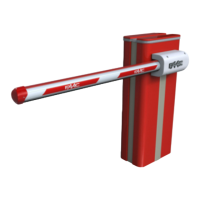B680H 16 732719 - Rev.D
8 mm
30-50 mm
~ 1 m
DL3
DL4
LOOP 1
LOOP 2
2
2
22456
7
Translation of the original instructions
ENGLISH
6.1.3 Calibration
Each time the E680 board is powered, the integrated loop detector
performs a calibration of the connected loops. Therefore, you can
perform calibration by cutting off power to the board for at least 10
seconds and then reconnecting it.
From the barrier status display, you can press, at any time, SW4/CAL1
to calibrate the loop connected to the LOOP 1 input or SW5/CAL2 to
calibrate the loop connected to the LOOP2 input.
Calibration is highlighted by the board diagnostics by fl ashing LEDs
DL3 and DL4, and when calibration is completed, they will indicate the
loop detection status, if connected.
The other signals provided by the board diagnostics are described in
the following table:
If one or both magnetic loops are not installed, the loop
detector, following a fi rst attempt to calibrate, will keep
the status LEDs fl ashing every 5 seconds (as shown in
the above table)
6.1.4 Adjusting sensitivity
By adjusting the sensitivity of the loop detector, you determine the
variation of inductivity, for each channel, that a vehicle must cause in
order to activate the corresponding detector output.
Sensitivity is adjusted separately for each channel using the two
parameters S1 and S2 in BASIC programming.
6.1.5 Making the loops
The loop must be laid at least 15 cm from fixed metal objects, at least
50 cm from moving metal objects and no more than 5 cm from the
surface of the final paving.
Use a standard unipolar cable measuring 1.5 mm² in diameter (if the
cable is laid below ground level directly, it must have double insulation).
Make a preferably square or rectangular loop by preparing a PVC cable
duct or by tracing the paving, as shown in figure 16 (the corners must
be cut at a 45° angle to avoid cable breaks). Lay the cable using the
number of windings shown in the table. The two ends of the cable must
be twisted together (at least 20 times per metre) from the loop to the
E680 board. Avoid splicing a cable (if necessary, weld the conductors
and seal the splice using a heat-shrinking sheath) and keep it separate
from the mains power lines.
6.2 EXPERT programming
EXPERT programming is used only in the event that operation logics
customisation is already stored.
Before making changes at this level, be certain that
the steps you wish to change and their effect on the
automated system are fully understood.
Changing the EXPERT programming parameters involves
indicating the
CU value on the LO parameter of the BASIC
programming.
To access EXPERT programming, press F and, holding it, press +
for approximately 10 seconds.
The use of F, + and - in this menu is the same as in the other two
programming levels.
LED Status LOOP Status
Off Loop clear
On Loop engaged
Flashing (0.5 s) Loop calibration
in progress
Rapid flashing Loop short circuit
Slow flashing
(5 s)
No loop
or loop interrupted
Two flashes (every 5 s) Non-conforming loop
(heater or inductance out
of range)
Loop
Perimeter
Nr.
of Windings
less than 3 m 6
from 3 to 4 m 5
from 4 to 6 m 4
from 6 to 12 m 3
more than 12 m 2
Making the loops

